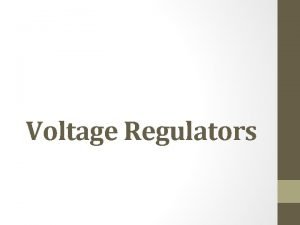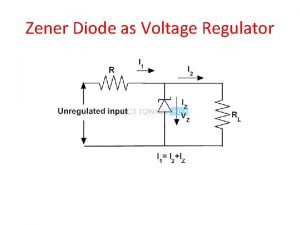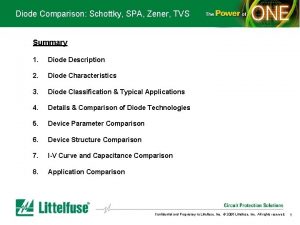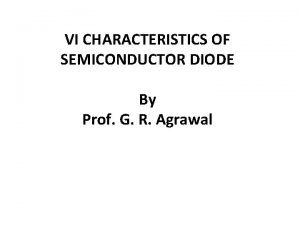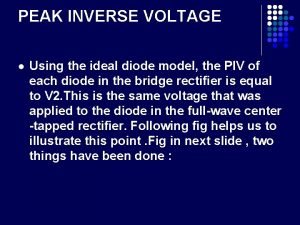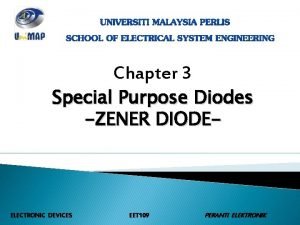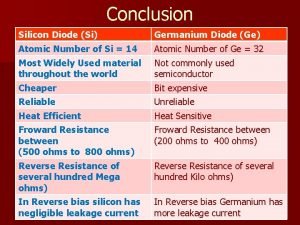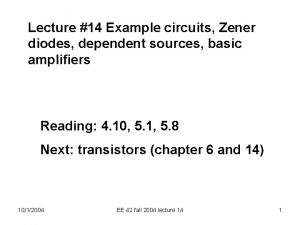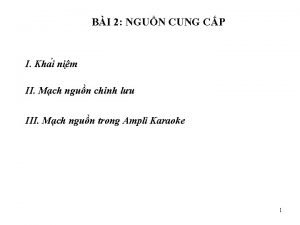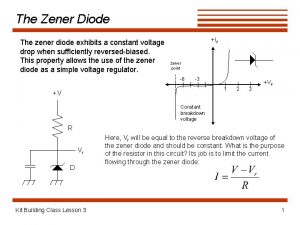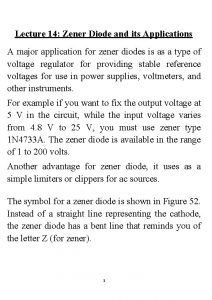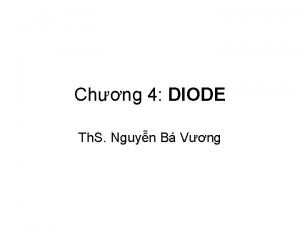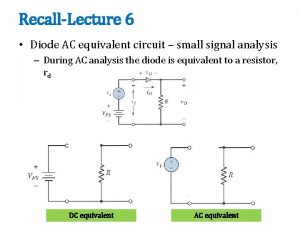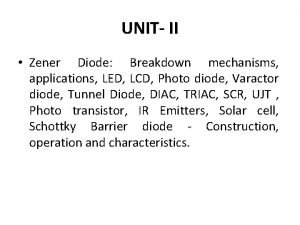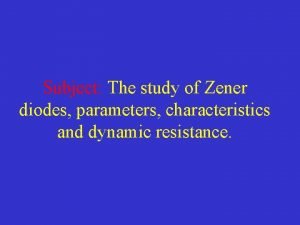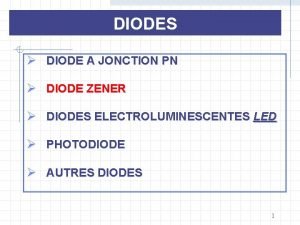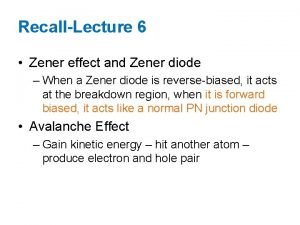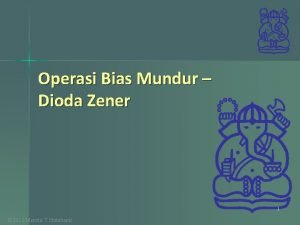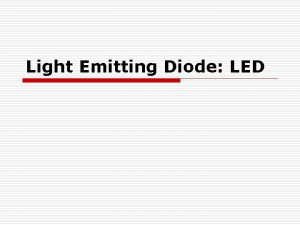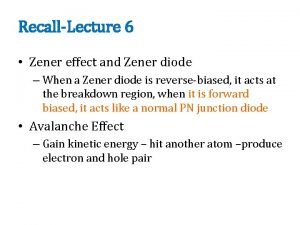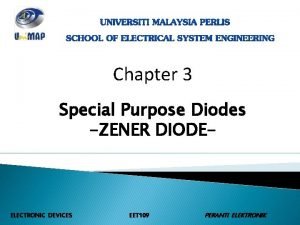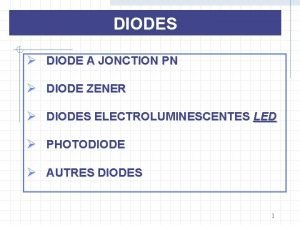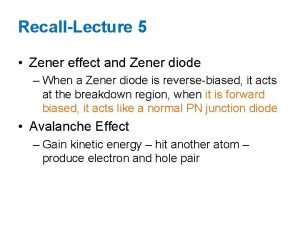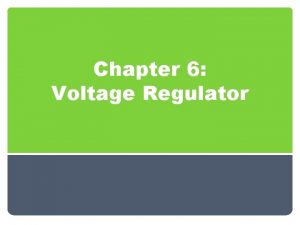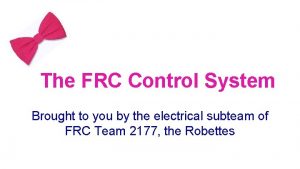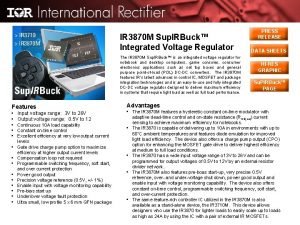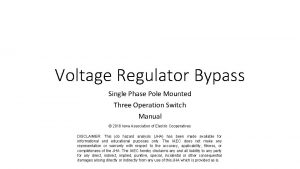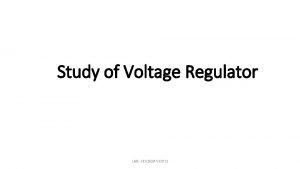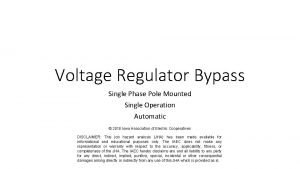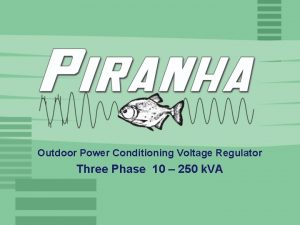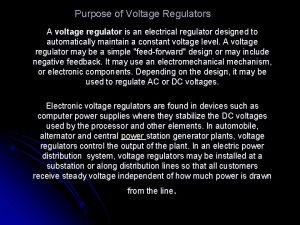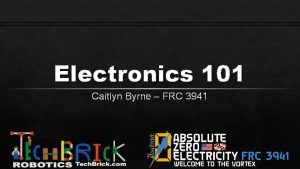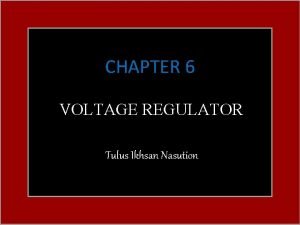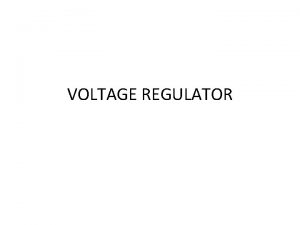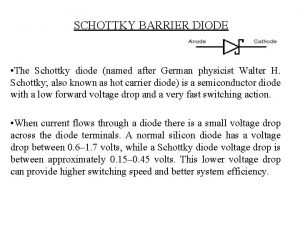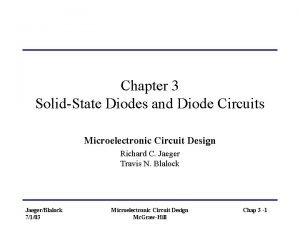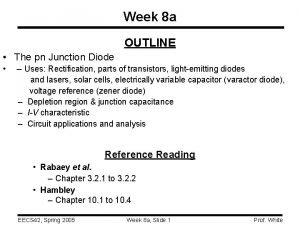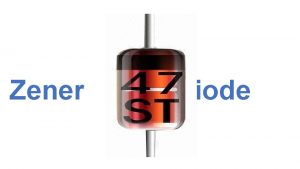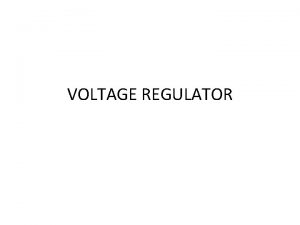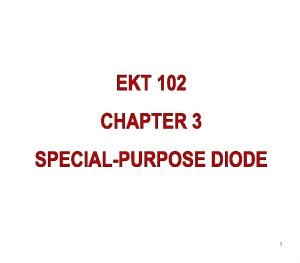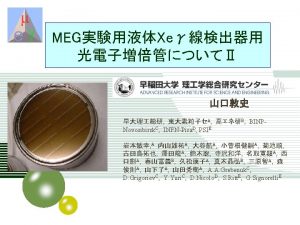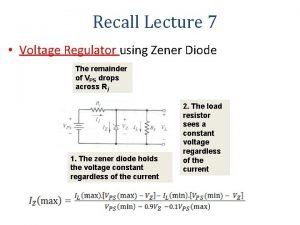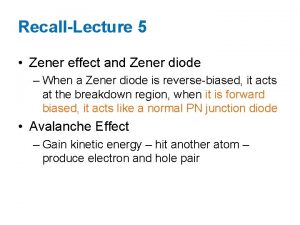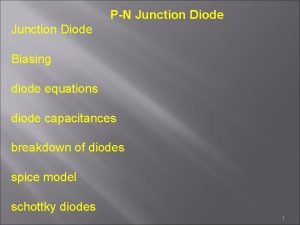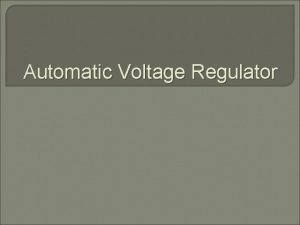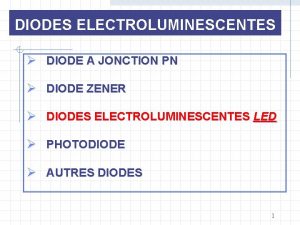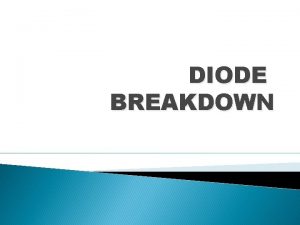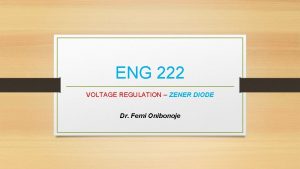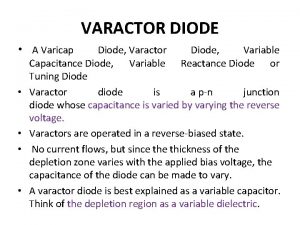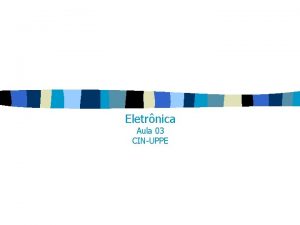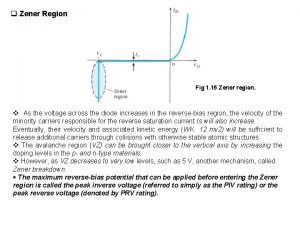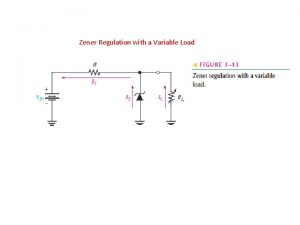Zener Diode as Voltage Regulator Voltage Current Equations








































- Slides: 40

Zener Diode as Voltage Regulator

Voltage & Current Equations 1. Is= Iz+IL 2. Iz= Is-IL 3. Vo= Vi-Is. Rs All above equations are according to KCL & KVL.

Applications • It is used in the emitter follower regulator. • In DC power supplies.

5. TRANSDUCERS & SENSORS 13 Marks

INSTRUMENTATION SYSTEM

TRANSDUCER • Definition: - It is device which convert physical quantity which is to be measured in to an equivalent electrical signal (voltage or current). Functions of transducer: 1) To detect & sense parameter, magnitude & any change in physical quantity. 2) To provide proportional electrical output signal.

Selection Criteria of Transducer • • • Linearity Accuracy Sensitivity Operating Range Minimum sensitivity Frequency responded • • • Speed of response Reliability Cost of sensors Output power Nature of output Maintenance of sensor

TRANSDUCER CHARACTERISTIC STATIC CHARACTERISTICS DYNAMIC CHARACTERISTICS • Output of transducer is time independent w. r. t. to variation input of transducer • Types: 1. Response time 2. Rise time 3. Time constant 4. Setting time

COMPARISON BETWEEN ACTIVE & PASSIVE TRANSDUCER Active Transducer • No external power supply is required • Secondary transducer • This transducer convert measurement input into electrical signal • Examples: Thermocouple, photo voltage sensor, photo cell, piezoelectric transducer Passive Transducer • External power supply is required • Primary transducer • This transducer convert measurement into variation in resistance capacitance • Examples: Thermistors, LDR, LVDT, Photo Transistor

CLASSIFICATION OF TRANSDUCERS • • Primary & Secondary Transducers Passive & Active Transducers Analog & Digital Transducers Mechanical & Electrical Transducers

PRIMARY TRANSDUCER • The Transducer which responds to the change in physical quantity & convert in to nonelectrical quantity is called as Primary Transducer. • E. g. Strain gauge

SECONDARY TRANSDUCER • The transducer which responds to physical quantity & convert it into Analog electrical quantity is called as Secondary Transducer. • E. g. Photo diode, Quartz crystal

Passive Transducers • The transducer which require external power source for its operation is called passive transducers. • E. g. LDR

Active Transducers • The transducers which do not require external power source for their operation is called Active Transducers. • E. g. Thermocouple

Analog Transducers • The transducers which convert input quantity in to analog output as a continuous function of time is called as Analog transducers. • E. g. LVDT

Digital Transducers • The transducer which converts the input quantity into electrical output in the form of pulses is called as Digital transducers. • Pressure sensor

ELECTRICAL TRANSDUCER • Definition: Transducer which convert physical quantity is to be measured in to electrical quantity. e. g. Thermistor : temperature to electrical LDR : light to electrical photo diode: light to electrical photo transistor: light to electrical

MECHANICAL TRANSDUCER • Definition: Transducer which convert physical quantity is to be measured in to mechanical quantity such as pressure, displacement etc. e. g. Diaphragms: pressure to displacement Bellows: pressure to displacement Bourdon tube: pressure to displacement Capsule: pressure to displacement

Comparison of & Passive Transducers Passive Transducer • It operates under energy controlling principle. • It require external power supply. • The energy required for the production of the output signal is obtained from the power supply. • E. g. Thermistors, strain gauge, LDR etc. Active Transducer • It operates under energy conversion principle. • Not require external power supply. • The energy required for the production of the output signal is obtained from the physical quantity. • E. g. Photovoltaic cell, Piezoelectric crystal etc.

Comparison of Electrical & Mechanical Transducers • • • Mechanical Transducers It does not need power supply. There are moving parts. It is less reliable. It has less life span. It require more operating time. E. g. Manometers, Hydrometer, bellows etc. Electrical Transducers • • • It needs power supply. There are no moving parts. It is more reliable. It has more life span. It require less operating time. E. g. LVDT, Photovoltaic cell, piezoelectric crystal etc.

Comparison of Analog & Digital Transducers Analog Transducer • The transducers which convert input quantity in to analog output as a continuous function of time is called as Analog transducers. • Its output is analog in nature. • E. g. Thermistors, Strain gauge etc. Digital Transducer • The transducer which converts the input quantity into electrical output in the form of pulses is called as Digital transducers. • Its output is digital in nature. • E. g. Rotary encoder, shaft encoder etc.

Resistive Transducers • The transducer that covers the parameters to be measured into change in resistance which can be calibrated in terms of the measurand is called as Resistive Transducer. • E. g. LDR, Strain gauge etc.

Strain Gauge • Strain gauge is an elastic resistive transducer, which converts the mechanical elongation and compression into resistance change. • Types: 1) Wire gauge 2) Foil gauge 3) Thin film gauge 4) semiconductor

Inductive Transducer • The transducer that converts the measurand into change in inductance which can be calibrated in terms of the measurand is called an inductive transducer. • E. g. Inductive proximity transducer, LVDT.

Linear Variable Differential Transducer


Capacitive Transducer • The transducer that converts the parameters to be measured into change in capacitance, which can be calibrated in terms of measurand is called as capacitive transducer. • E. g. VCDT


Piezo-Electric Transducer • Piezo-Electric Effect: - When mechanical stress or pressure is applied across the crystal, it becomes polarised and e. m. f. generated across the crystal is known as piezo-electric effect. • Piezo-electric material 1)Rochelle salt 2) Quartz

Photo diode • Operation of both is depending on the falling light intensity.

Applications of Photodiode • • • The photodiode is used in optical communication system. The photodiode is used in automotive devices. The photodiode is used in medical devices. It is used in solar cell panels. The Photodiode are used in consumer electronics devices like smoke detectors, compact disc players, and televisions and remote controls in VCRs. It is used for exact measurement of the intensity of light in science & industry. It is used in character recognition circuit. It is used in camera light meters, and street lights. It is used in demodulation. The photodiode is used in logic circuit. It is used in photo detection circuits.

Photo Transistor

Applications of Phototransistors • • • Counting Systems Encoder sensing and object detection Printers and Optical control remotes Light detector Level Indication and Relays

Proximity Sensors • A proximity sensor is a sensor able to detect the presence of nearby objects without any physical contact. • Types: 1. Inductive proximity sensor 2. Capacitive proximity sensor 3. Optical proximity sensor 4. Pneumatic proximity sensor 5. Ultrasonic proximity sensor

Applications

Inductive Proximity Sensor • These are proximity sensors designed to detect metal objects. • It is used in heavy duty industrial applications.

Advantages of Inductive sensor • It can withstand harsh environmental conditions. • It has longer life. • It is very easy to install. • It has very predictable results and performance. • It has higher switching rate.

Disadvantages of Inductive sensor • Only detects metallic object • Operating range is shorter than other sensors • Affected by strong electromagnetic field


Thank You!!
 Shunt voltage regulator
Shunt voltage regulator Static characteristics of sensors
Static characteristics of sensors Tvs diode vs schottky
Tvs diode vs schottky Pn junction diode and zener diode difference
Pn junction diode and zener diode difference Diode peak inverse voltage
Diode peak inverse voltage Izk zener diode
Izk zener diode Germanium diode breakdown voltage
Germanium diode breakdown voltage Zener diode
Zener diode Diode zener
Diode zener Zener diodes exhibit
Zener diodes exhibit Lambang dioda zener
Lambang dioda zener Zener diode application
Zener diode application Mạch chỉnh lưu bội áp
Mạch chỉnh lưu bội áp Zener diode
Zener diode Small signal equivalent circuit of diode
Small signal equivalent circuit of diode Energy band diagram of zener diode
Energy band diagram of zener diode Zener diode parameters
Zener diode parameters Zener diode junction
Zener diode junction Zener diode function
Zener diode function Application of zener diode
Application of zener diode Bias maju dan bias mundur
Bias maju dan bias mundur Diode led polarity
Diode led polarity Zener diode
Zener diode 4733 zener diode
4733 zener diode Zener diode junction
Zener diode junction P-n junction diode as half wave rectifier
P-n junction diode as half wave rectifier Type of regulator
Type of regulator Frc power distribution panel
Frc power distribution panel Fully integrated voltage regulator
Fully integrated voltage regulator Regulator bypass switch
Regulator bypass switch Voltage regulator ic 723
Voltage regulator ic 723 Regulator bypass switch
Regulator bypass switch Power conditioning voltage regulator with front access
Power conditioning voltage regulator with front access Integrated voltage regulator
Integrated voltage regulator Frc pcm
Frc pcm Op amp shunt regulator
Op amp shunt regulator In a voltage regulator network with fixed rl and r
In a voltage regulator network with fixed rl and r Types of ac voltage controller
Types of ac voltage controller Schottky diode definition
Schottky diode definition Voltage across diode
Voltage across diode Current through diode formula
Current through diode formula
